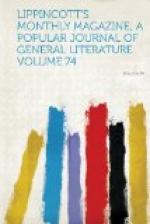There was just a moment of suspense and suppressed excitement, when, with a sharp cry, the miner loosened his hold, and by the impulse of our own weight we shot, with a velocity not to be described, two hundred and forty-feet into the earth. The miner acting as a brake brought us up gently enough, so that we felt scarcely anything of a shock. Cecilia, to be sure, left her breath about two-thirds of the way up, and suffered some inconvenience till she accumulated more, and the curate forgot to loosen his hold on Elise for an unpardonable length of time, while he gathered his wits, and I could feel that he was blushing when he came to his senses. It was in adjusting our attire that we discovered the necessity and value of our leathern aprons. Had we been plunged into a pool of water we should have sizzled. They were hot from the friction. They speedily became our dearest of friends and possessions, for we had three more of these shafts to slide down, and we grew faint at the bare thought of losing them. Cecilia, after our second slide, suggested, in a language the gentlemen did not understand, that she would like her turn at being embraced, since she always lost her breath at the start and was afraid. This remark met with no response, as neither Elise nor I wanted to run the risk of being lost off behind, and felt a selfish sense of security that made the shooting of the shafts delightful and somewhat similar to the coasting and sliding down balusters of our childhood.
We traversed many long galleries on different levels. Through some of these ran the aqueduct which brought the fresh water in, and another which conveyed the salt water out, twenty miles away. We were in the bosom of a mountain of salt rock, which is constantly forming, and is therefore a never-ending source of wealth. For centuries this mine has been worked. The salt rock is quarried and carried out in the form of rock-salt. Another method of obtaining salt is by conveying water into the large, excavated chambers, drawing it off and boiling down when it becomes impregnated. This water attracts and dissolves the saline matter, but, as water cannot so affect the slaty portion of the rock, it leaves it often in most fantastic shapes, sometimes as pillars or depending, curtain-like sheets. These chambers kept full of water are constantly changing their level on the withdrawal of the liquid. After three or four weeks two feet of the roof will be found to have been dissolved and two feet of debris found upon the floor. Curiously enough, this debris in time acquires the property of the salt rock. There are chambers above chambers, some of them five hundred yards in circumference, and miles of galleries. One of these chambers, which was illuminated, showed floor, walls, and ceiling of pure rock-salt, very lovely in color, though not so brilliant as in the mine of Wieliczka, which is likened to four subterranean cities, one below the other, hewn from rose-colored rock. Samayana secured of our guide red, yellow, blue, and purple specimens.




